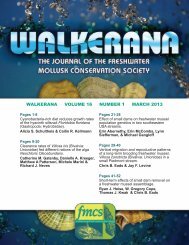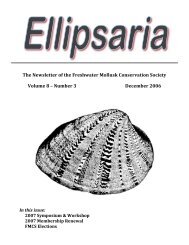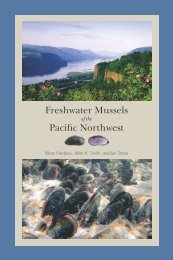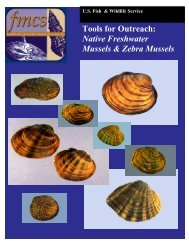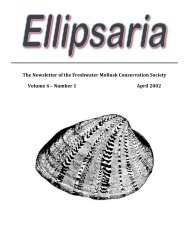Ellipsaria - Freshwater Mollusk Conservation
Ellipsaria - Freshwater Mollusk Conservation
Ellipsaria - Freshwater Mollusk Conservation
Create successful ePaper yourself
Turn your PDF publications into a flip-book with our unique Google optimized e-Paper software.
New Depths for the Florida Apple Snail,<br />
Pomacea paludosa<br />
Jennifer L. Bernatis<br />
School of Natural Resources and Environment,<br />
University of Florida, Gainesville, FL<br />
bernatis@ufl.edu<br />
The Florida apple snail, Pomacea paludosa, is the only apple<br />
snail native in the United States. P. paludosa is found<br />
throughout Florida and is the primary food source for the<br />
endangered Everglade Snail Kite, Rostrhamus sociabilis<br />
plumbeus (Darby, 2005; Kushlan, 1975). The snail was once<br />
abundant in many locations throughout Florida, but population<br />
numbers have been suspected to be declining in recent years.<br />
Reasons for this decline may include environmental<br />
perturbations (i.e. pollutants, water levels), destruction of<br />
habitat, and establishment of populations of non-native apple<br />
snails belonging to the Pomacea canaliculata complex. Darby<br />
et al. (2002) suggested P. paludosa exhibits an aversion to<br />
water depths greater than 50 cm. Reasons for this include the<br />
need to breathe atmospheric air, and the amount of energy<br />
required to move up to the water/air interface. Darby (1998)<br />
also suggested that the accumulation of unconsolidated organic<br />
material may restrict movement into deep water. Reduced<br />
food availability, habitat structure, and low levels of dissolved<br />
oxygen may also account for the absence of snails in deeper<br />
water. However, recent observations and collections of<br />
P. paludosa in Apopka Spring may suggest that depth is not a<br />
deterrent to the snails.<br />
Apple snails were observed in Apopka Spring over several<br />
monthly sampling trips by diver Tom Morris, of Karst<br />
Environmental Services (High Springs, FL). In April 2010,<br />
snails were collected and identified as P. paludosa. Four<br />
snails were removed from the spring vent. Two of the snails<br />
were collected at 12.2 m, one at 13.1 m and the last at 14.6 m.<br />
The three snails at the lesser depths were all firmly attached to<br />
the rocky substrate. The deeper snail was loosely attached and<br />
resting on the substrate. Temperature in the spring was<br />
23.3 o C and the water was clear. There was no vegetation in<br />
the spring vent and no snail egg masses were observed near<br />
emergent vegetation around the boil. Although flow at the<br />
spring vent was measured at 20 cfs, the flow at the location of<br />
the snails was 1-1.5 cfs. The snails were taken to a laboratory<br />
facility and remained in good condition until July 2010.<br />
Water level requirements of apple snails continue to be of<br />
interest as they are the primary food source for the endangered<br />
Everglades Snail Kite. However, while the snail may prefer<br />
less deep habitat, this finding may provide insight into where<br />
the snails are finding refuge in periods of environmental<br />
perturbations. Locations with deeper holes, particularly spring<br />
systems, where snail populations are presumed reduced or<br />
extirpated, need to be surveyed for the presence of snails; as<br />
the presence of snails in these locations may be indicative of<br />
other water quality problems.<br />
Darby, P. 2005. Apple snail abundance in Snail Kite foraging<br />
sites on Lake Okeechobee in 2005. Annual Report for<br />
Florida Fish and Wildlife <strong>Conservation</strong> Commission.<br />
6<br />
Darby, P., Bennetts, R., Miller, S., and Percival, H. 2002.<br />
Movements of Florida apple snails in relation to water<br />
levels and drying events. Wetlands 22(3) 489-498.<br />
Darby, P. 1998. Florida applesnail (Pomacea paludosa Say)<br />
life history in the context of a hydrologically fluctuating<br />
environment. Ph.D. Dissertation. University of Florida,<br />
Gainesville, FL, USA.<br />
Kushlan, J. 1975. Population changes of the apple snail,<br />
Pomacea paludosa, in the southern Everglades. The<br />
Nautilus 89(1) 21-23.<br />
A Recent Record of the Cumberland<br />
Moccasionshell, Medionidus conradicus<br />
(Bivalvia: Unionidae), from Alabama<br />
Stuart W. McGregor<br />
Geological Survey of Alabama<br />
P.O. Box 869999 Tuscaloosa, AL 35486<br />
smcgregor@gsa.state.al.us, 205-247-3629<br />
The freshwater mussel genus Medionidus Simpson, 1900, is<br />
found in the southeastern United States from Florida north to<br />
Kentucky and Virginia, and west to Mississippi, and is<br />
comprised of six species, four of which occur in Alabama.<br />
The type species, Medionidus conradicus (Lea, 1834)<br />
(Cumberland Moccasinshell), is a Cumberlandian species<br />
historically widespread in the Cumberland River system<br />
downstream of Cumberland Falls, Kentucky and Tennessee,<br />
and in the Tennessee River system from southwestern<br />
Virginia, western North Carolina, and eastern Tennessee<br />
downstream to the historic Muscle Shoals in northwestern<br />
Alabama. While records have been secured from numerous<br />
locations within these areas, it was collected only as<br />
archaeological material in the main stem Tennessee River in<br />
Alabama at Muscle Shoals before impoundment of the river by<br />
TVA, but likely was present elsewhere (Williams et al. 2008).<br />
In Alabama the Cumberland Moccasinshell persists in the<br />
upper Paint Rock River system in Jackson County near the<br />
Alabama/Tennessee state line and in Foxtrap Creek, a<br />
headwater tributary of Spring Creek in Colbert County<br />
(Mirarchi et al. 2004, Williams et al. 2008).<br />
Like its congeners, Medionidus conradicus is a relatively small<br />
species, reaching a maximum size of about 60 mm. It is<br />
usually found in riffles and runs in small creeks (e.g. Spring<br />
Creek) to medium rivers (e.g. Paint Rock River), but may be<br />
found in larger rivers under conditions mimicking a small<br />
stream environment, such as the braided channels found at the<br />
pre-impoundment Muscle Shoals. It is often found under large<br />
flat rocks and uses a byssal thread for attachment to the<br />
substrate. Its preferred fish hosts (from laboratory trials)<br />
include Etheostoma caeruleum Storer, 1845 (Rainbow Darter),<br />
Etheostoma flabellare Rafinesque, 1819 (Fantail Darter),<br />
Etheostoma rufilineatum (Cope, 1870) (Redline Darter), and<br />
Etheostoma virgatum Jordan, 1880 (Striped Darter) (Mirarchi<br />
et al. 2004, Williams et al. 2008).<br />
The Cumberland Mocassinshell’s preference for free-flowing<br />
streams and its dependence on host fishes also suited to that<br />
habitat render it especially susceptible to the deleterious effects<br />
of impoundment, the inundation of riffles and runs by



